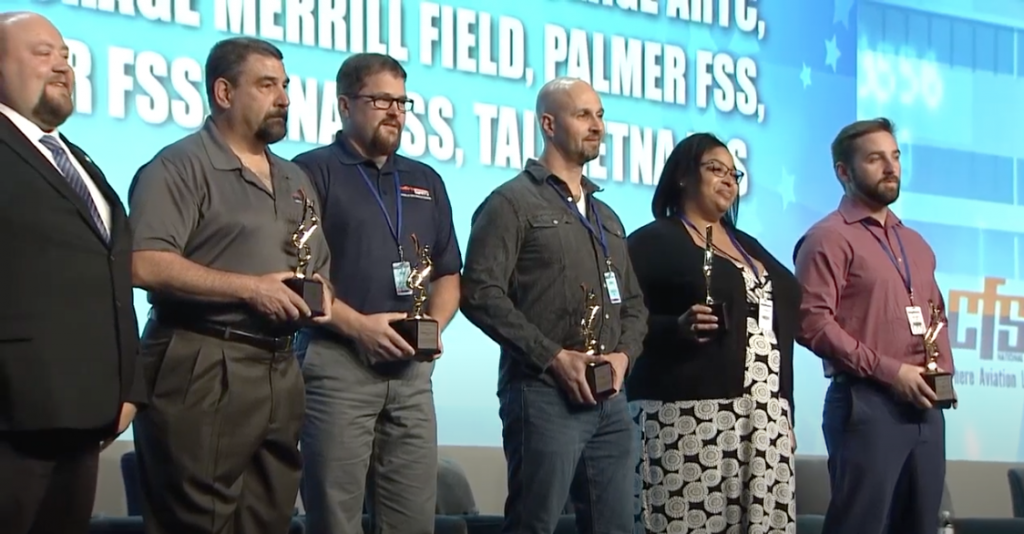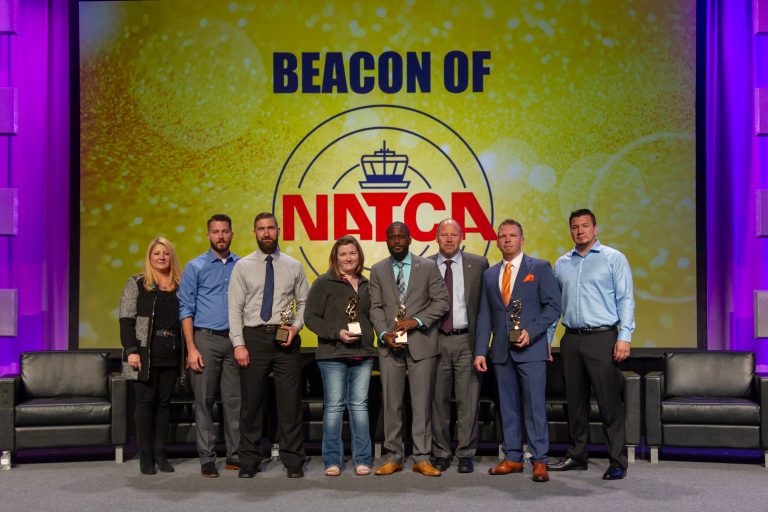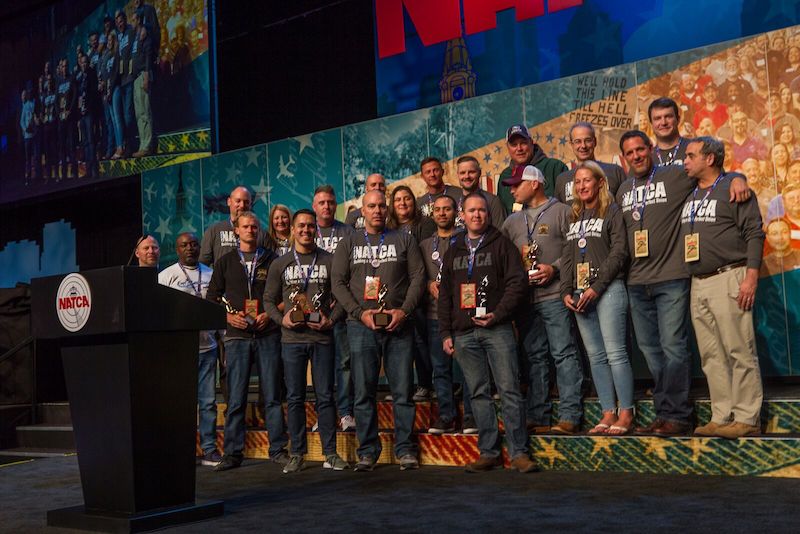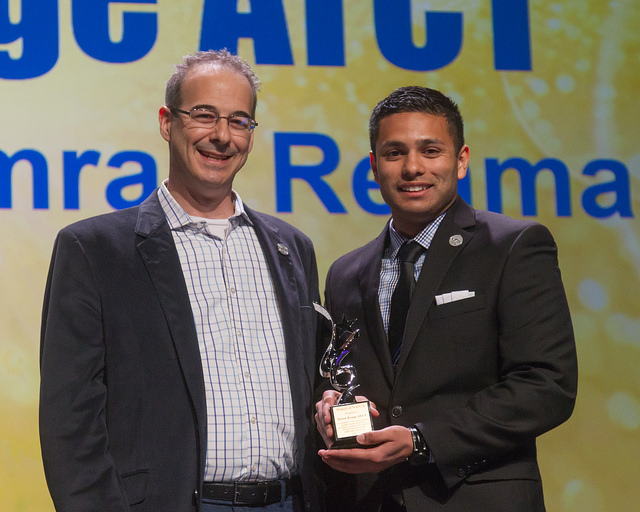
Recipients of the Beacon of NATCA Award:
2019: Alaskan Facilities

At Communicating For Safety 2019, NATCA presented this award to Anchorage ATCT (ANC), Anchorage TRACON (A11), Merrill Field ATCT (MRI), Anchorage Center (ZAN), and NATCA-represented Flight Service Stations for their response to the Nov. 30, 2018, earthquakes that struck Anchorage, Alaska, and severely damaged homes and businesses.
The towers swayed violently, and members were thrown on the floor and equipment in the facilities were falling around them. It was a scary day for everyone. Most controllers kept working without knowing the conditions of their own homes.
“Time and again, when a catastrophic event occurs, our members roll up their sleeves and get to work, displaying their professionalism and dedication to the National Airspace System,” Alaskan Regional Vice President Clint Lancaster said.
Watch award presentation below.
2018: Las Vegas ATCT, Las Vegas TRACON, Seattle ATCT, Seattle TRACON

The team of NATCA members at Seattle TRACON and Seattle ATCT were honored for the exceptional care, skill, and professionalism they displayed during an incident on Aug. 10 in which a Horizon Air employee stole, flew, and then crashed an aircraft.
At Seattle TRACON, Kimberly Brooks credited the entire crew on duty for performing a great team effort. “It was really incredible; the collaboration with Sea-Tac Tower and the way the room was reconfigured to handle the situation,” she said. “Seattle Center (ZSE) did an incredible job with the traffic coming in and redirecting them. I’m new to the FAA. The majority of my time has been military. It was incredible, the response, and then afterwards the support. The CISM (Critical Incident Stress Management) crew came. That was very helpful.”
The team of NATCA members working at both Las Vegas ATCT (LAS) and Las Vegas TRACON (L30) were honored for keeping air traffic and passengers safe during the evening of Oct. 1, 2017, when the horrific shooting of concert goers at the Route 91 Harvest occurred just a short distance from McCarran International Airport.
Jamaal Haltom (LAS) and Anthony Borgert (L30) described how controllers at each facility rose to the occasion despite an assortment of challenges, starting with the initial confusion over what exactly was happening and the fear that LAS controllers might be shot at.
“Ideally, you would have an all-knowing understanding of what was occurring,” Borgert said. “But that’s not reality. You work with what you know.”
Haltom said initial reports were of multiple shootings on the Strip. Controllers believed they might be at risk and debated whether to stay in the tower. Then a call came from an off-duty LAS controller who was at the concert, escaped the gunfire, and had the presence of mind to call the tower to frantically ask them to stop the helicopter traffic over Mandalay Bay and that part of the Strip.
“You had people on the runways,” Jon Weaks said. “Were they shooters or being shot at? There were so many things going on and just a level, calm voice from air traffic control. They were coordinating on the fly. Everyone in this room owes LAS and L30 a huge shout out.”
Watch award presentation below.
2018: Facilities and Members of the Southwest and Southern Regions Affected by Hurricanes Harvey, Irma, and Maria

In April 2018 at the 17th Biennial Convention in Philadelphia, NATCA took time to commend the facilities and individuals who worked under unthinkable conditions and rose up to support the National Airspace System and their brothers and sisters during a year (2017) of unprecedented natural disasters. NATCA recognized some of the facilities that were affected by hurricanes Harvey, Irma, and Maria for their “inspiring effort during a disaster event and providing exceptional ATC services,” even through the devastation. Many facilities were affected by the storms as they helped lessen the burden of keeping the skies open and safe, but the Beacon of NATCA award went to those most severely devastated by the storms.
The scope of these particular disasters and the relief efforts that followed went beyond the ATC services NATCA members provided from facilities. NATCA was compelled to recognize individual NATCA members for their generosity, hope, enthusiasm, dedication, organization, and willingness to do whatever is necessary to help those in need. Another version of the Beacon of NATCA was created this year to recognize individuals for their “contribution during a disaster event in support of the National Airspace System and the professionals who operate it,” as the award inscriptions read.
It was a record-breaking year of disasters on several fronts. Natural disasters in the United States included droughts, floods, mudslides, tornados, and unthinkable wildfires. Requests for federal aid for disaster relief increased ten-fold from 2016. The most destructive wildfires in California’s history ravaged the state for weeks, killing dozens of people and destroying vast swaths of land and property. Several states saw record-breaking flooding and temperatures. Any of these disasters would constitute a devastating year, but Mother Nature wasn’t done. Hurricanes Harvey, Irma, and Maria wreaked enduring damage throughout the Caribbean, Southern United States, and Texas in the most destructive hurricane season the United States has ever seen in both fatalities and property damage.
NATCA honored Houston Center (ZHU), Houston TRACON (I90), Houston Intercontinental ATCT (IAH), Houston Hobby ATCT (HOU), and Beaumont-Port Arthur ATCT for their work around the clock. Members Jenifer McCoy (D10) and Jeff Duer (ZFW) and ZHU member Ashley Amato were also honored for their individual efforts.
St. Thomas ATCT (STT), San Juan CERAP (ZSU), Miami Center (ZMA), and San Juan ATCT (SJU), were also honored. Woody Camp (ZSU), Kyrandgel Rios (SJU), ZMA Area Representative Javier Betancourt, SAV member Mary Mayconich-Beasley, MIA Area Representative Frank Bullock, and ZMA Vice President Tom Flanary were honored for their individual contributions during and after the storms.
NATCA also honored several Engineer/Southern Region (ESO) members for their essential work planning for, repairing, and rebuilding after Hurricanes Maria and Irma. Engineers Alan Stensland, Bruce Williams, and Chris Atkinson were recognized, represented by ESO FacRep Chris Dalbec.
Watch award presentation below.
2017: Baton Rouge ATCT (BTR)

On the first day of heavy rain, Aug. 11, 2016, Baton Rouge (BTR) member Mat Lehnert thought nothing of it. “Nobody considered it a big deal,” he said. But by Friday, Aug. 12, the rain was falling at rates of two-to-three inches per hour and everyone began to grow more anxious.
“We were like, ‘hold on, this isn’t right,” Lehnert recalled thinking.
It wasn’t until late that evening and early into Saturday morning, Aug. 13, that what meteorologists called a “mesoscale convective system around a weak area of low pressure” finally moved off its stationary location. But by then, The Washington Post later noted, the storm dumped three times as much rain on Louisiana as Hurricane Katrina in 2005 – the equivalent of 7.1 trillion gallons of water or enough to fill Lake Pontchartrain about four times.
That’s when the situation turned from bad to catastrophically worse. A flash flood emergency was declared on Aug. 13 as rivers and tributaries carrying the swollen water flows could not contain the overflow. Baton Rouge found itself right in the middle of it, with areas to the east and south of downtown hardest hit.
To the north of town, where BTR is located, NATCA members began a week-long stretch of air traffic control operations that nearly doubled their normal weekly volume.
From Aug. 5-12, BTR members handled 1,564 operations. But from Aug. 13-19, that number jumped to 2,775. Military operations accounted for 780 of those operations at the height of the rescue and relief missions in the area. A normal week of military ops might reach between 50-100, said BTR member Imran Rehman (pictured above with Southwest Regional Vice President Andrew LeBovidge.
Rehman accepted the Beacon of NATCA award on BTR’s behalf at Communicating For Safety and shared his thoughts on the event:
I woke up that Saturday in August to a single thought in my head: “Great … my A/C stopped working again.
Little did I know the situation was much worse. I made my way to work, the only home I had left. A place filled with people that I am proud to call my brothers and sisters. My family.
There is an old French proverb that says, “it is the fate of glass to break.” During that week, Baton Rouge was made of anything but.
On behalf of my brothers and sisters at Baton Rouge, I would like to sincerely thank all of the first responders, Coast Guard units, and everyone else who helped with the rescue effort.
And finally, thank you to NATCA for supporting and recognizing the hard work and sacrifices my facility made. Thank you.
Watch award presentation at CFS 2017 below.

